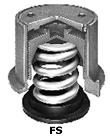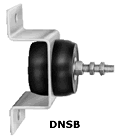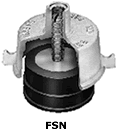Acoustical Isolation Products
Floating Floors, Walls and Ceilings Overview
 The idea of pouring a secondary floor on an elastic medium goes back as long as we can remember. Cork was the first material, but because of its high frequency, early floating floors were not too effective. The method of pouring concrete on plywood supported by fiberglass was improved upon by substituting EAFM-AASHO bridge-bearing neoprene mounts for the glass. Panels are not the best approach however, and the jack-up system is recommended. The secondary floor is poured around FS-1702 or FSN mounts on plastic sheeting spread over the sub floor. The cured slab is lifted by turning the adjustment bolts in each mount. No plywood is left beneath the floors; there is no possibility of concrete breaking through the form work to short circuit the system, and larger more effective air gaps can be used at no increase in cost. Mountings are usually placed on 54” centers with closer spacing in areas carrying heavier loads. The FS spring design is used for those applications where impact rather than sound is the major problem. These jack-up systems were both developed and proven by Mason Industries and there is acoustical and structural test data to back up these recommendations.
The idea of pouring a secondary floor on an elastic medium goes back as long as we can remember. Cork was the first material, but because of its high frequency, early floating floors were not too effective. The method of pouring concrete on plywood supported by fiberglass was improved upon by substituting EAFM-AASHO bridge-bearing neoprene mounts for the glass. Panels are not the best approach however, and the jack-up system is recommended. The secondary floor is poured around FS-1702 or FSN mounts on plastic sheeting spread over the sub floor. The cured slab is lifted by turning the adjustment bolts in each mount. No plywood is left beneath the floors; there is no possibility of concrete breaking through the form work to short circuit the system, and larger more effective air gaps can be used at no increase in cost. Mountings are usually placed on 54” centers with closer spacing in areas carrying heavier loads. The FS spring design is used for those applications where impact rather than sound is the major problem. These jack-up systems were both developed and proven by Mason Industries and there is acoustical and structural test data to back up these recommendations.
Floating walls and suspended ceilings complete the isolation. Walls should be resting on a continuous SWW pad, if not on the floating floor and sealed at the top with AB-716 angle brackets. Buckling is prevented by means of DNSB sway braces or the simpler WIC or WCL commonly used with fabricated walls. All of these devices use neoprene as the isolation media or natural rubber if specifically called for by an acoustical consultant.




